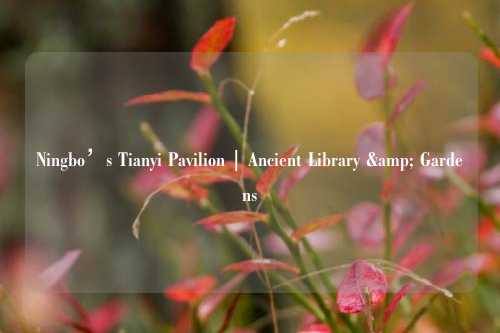Ningbo’s Tianyi Pavilion | Ancient Library & Gardens
Nestled in the heart of Ningbo, a vibrant city in Zhejiang Province, the Tianyi Pavilion stands as a testament to China’s enduring love for knowledge and art. Established in 1561, this extraordinary complex is not only the oldest surviving private library in China but also a breathtaking example of classical Chinese architecture. Combining the elegance of a library with the serenity of a ly designed garden, the Tianyi Pavilion offers a glimpse into the and intellectual legacy of the Ming and Qing dynasties.
The Tianyi Pavilion, also known as the Tianyi Ge, was built by Fan Qin, a wealthy scholar-official, and later expanded by his descendants. The library was originally intended to house Fan Qin’s extensive collection of books, which included rare manuscripts and works on various subjects such as literature, medicine, and astronomy. Over the centuries, the pavilion has grown to become a symbol of Ningbo’s rich heritage and a place where history and nature intertwine harmoniously.

One of the most striking features of the Tianyi Pavilion is its architecture. The main building, a two-story structure with a sloping roof and wooden carvings, is a masterpiece of classical Chinese design. The pavilion is surrounded by a beautiful garden, complete with rock formations, water features, and lush greenery. These elements work together to create an atmosphere of calm and reflection, making it the perfect setting for scholarly pursuits.
The library itself is a treasure trove of ancient knowledge. Although many of the original books have been lost or dispersed over the years, the pavilion still houses a significant collection of rare manuscripts and historical documents. These include works by famous Chinese scholars and philosophers, as well as insights into the social and life of the Ming and Qing periods. For history enthusiasts and book lovers alike, the Tianyi Pavilion is a must-visit destination.
But the pavilion is more than just a repository of knowledge; it is also a celebration of art and beauty. The wooden ceilings are adorned with carvings of dragons, flowers, and other symbolic designs, reflecting the sophisticated craftsmanship of the Ming and Qing eras. The garden, too, is a work of art, with its carefully arranged rocks, bonsai trees, and seasonal blooms. Each detail has been ly curated to create a harmonious balance between the man-made and the natural.
Despite its historical significance, the Tianyi Pavilion has managed to stay relevant in modern times. Today, it serves as a hub, hosting exhibitions, lectures, and workshops that bring the past to life. Visitors can explore its halls and gardens, immersing themselves in the atmosphere of bygone eras while learning about the city’s rich heritage. The pavilion’s programs and events also aim to preserve and promote Chinese art forms, such as calligraphy, painting, and tea ceremony, ensuring that future generations can continue to appreciate and enjoy these traditions.
In short, the Tianyi Pavilion is more than just a building; it is a living testament to China’s deep-rooted love for learning and culture. Whether you are a history buff, an art enthusiast, or simply someone looking for a peaceful retreat from the bustling city life, the pavilion offers something truly special. Its combination of ancient wisdom, stunning architecture, and serene gardens makes it a and unforgettable destination.
Walking through the Tianyi Pavilion, it’s easy to feel a deep sense of connection to the past. The pavilion’s enduring charm lies in its ability to transport visitors back in time, allowing them to glimpse into the lives of scholars and intellectuals from centuries ago. But beyond its historical significance, the pavilion is also a celebration of nature and beauty, with its ly designed garden offering a perfect escape from the modern world.
The garden surrounding the Tianyi Pavilion is a masterpiece of Chinese garden design. It features a variety of elements that are characteristic of classical Chinese gardens, such as rock formations, water features, and carefully pruned trees. These elements are arranged in a way that creates a harmonious balance between the built environment and the natural world. The garden is divided into several sections, each with its own character. There are areas for strolling, places for contemplation, and even a small koi pond that adds a touch of life and vibrancy to the landscape.
One of the most striking features of the garden is its use of rocks. The pavilion’s garden is home to a number of large, ornamental rocks that have been skillfully arranged to mimic natural mountain formations. These rocks are not only decorative but also serve as a focal point for the garden, drawing the eye and creating a sense of grandeur. The placement of these rocks is carefully thought out, with each one positioned to create a specific visual effect.
In addition to the rocks, the garden also features a variety of plants, including bamboo, pine trees, and flowering shrubs. These plants are chosen for their aesthetic appeal as well as their symbolic meaning. For example, bamboo is often associated with resilience and flexibility, while pine trees are symbols of longevity and wisdom. The garden’s design is not just about beauty; it is also about conveying meaning and telling a story through the use of nature.
The pavilion’s garden is also home to a number of historical artifacts and sculptures. These pieces, many of which date back to the Ming and Qing dynasties, add to the garden’s historical significance and provide visitors with a deeper understanding of the pavilion’s past. One of the most features is a stone inscribed with calligraphy by a famous scholar, which adds a touch of and intellectual depth to the garden.
For those interested in Chinese art and culture, the pavilion’s garden is a treasure trove of visual and intellectual stimulation. The garden’s design is a reflection of the Chinese philosophical principles that emphasize harmony, balance, and the connection between humanity and nature. These principles are evident in every aspect of the garden’s layout, from the placement of the rocks to the choice of plants.
Beyond its aesthetic appeal, the Tianyi Pavilion’s garden is also a place of tranquility and reflection. It offers a peaceful retreat from the hustle and bustle of modern life, allowing visitors to slow down and reconnect with their senses. The garden’s serene atmosphere is perfect for those looking to escape the stresses of the outside world and immerse themselves in a world of beauty and calm.
In addition to exploring the garden and the library, visitors to the Tianyi Pavilion can also take part in a variety of activities and events. The pavilion regularly hosts exhibitions, lectures, and workshops that highlight China’s rich heritage. These events provide a opportunity to learn about Chinese art forms, such as calligraphy, painting, and tea ceremony, and to engage with local artists and scholars.
For history enthusiasts, the pavilion’s programs offer a chance to delve deeper into the stories and experiences of the scholars and officials who once called the pavilion home. Through guided tours and interactive exhibits, visitors can learn about the lives of those who contributed to the pavilion’s rich history and gain a deeper appreciation for the and intellectual achievements of the Ming and Qing periods.
The Tianyi Pavilion is also a popular spot for tea lovers. The pavilion’s garden is home to a charming teahouse where visitors can enjoy a cup of Chinese tea while soaking in the beauty of the surroundings. The teahouse offers a wide variety of teas, from the earthy flavors of green tea to the bold, robust taste of oolong. For those looking to relax and savor the moment, the teahouse is the perfect place to unwind and enjoy the pavilion’s tranquil atmosphere.
, the Tianyi Pavilion is more than just a historical site; it is a place of beauty, culture, and intellectual inspiration. From its stunning garden to its rich historical collections, the pavilion offers a insight into China’s past and a chance to connect with the country’s deep-rooted love for learning and art. Whether you are a history buff, a nature lover, or simply someone looking for a peaceful retreat, the Tianyi Pavilion promises a truly unforgettable experience.
















